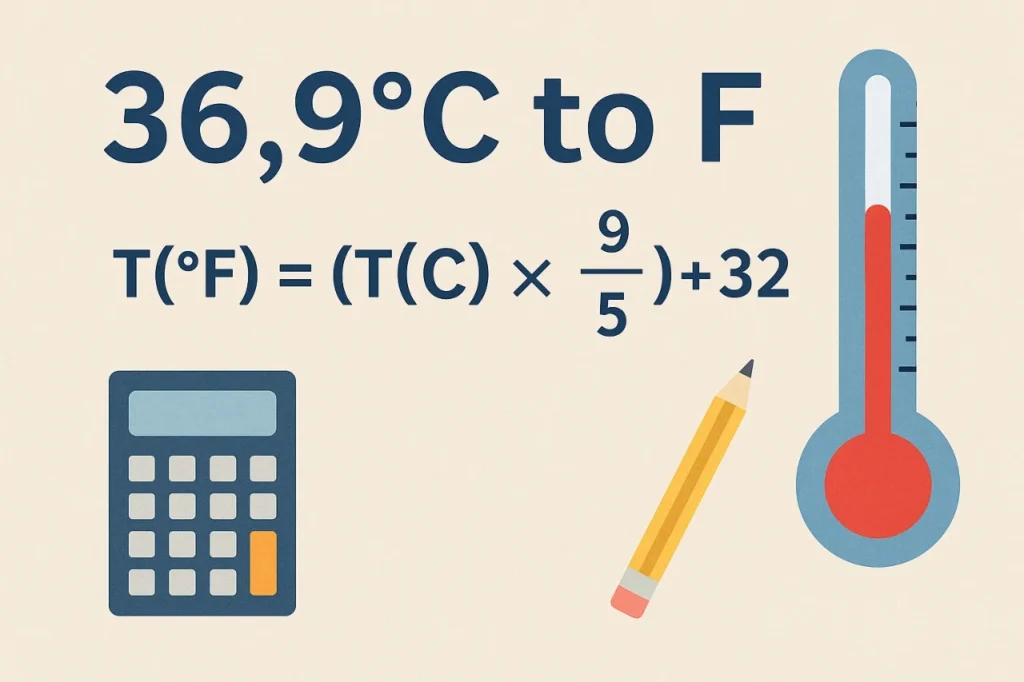When you come across a temperature like 36.9°C, you might wonder how it translates into Fahrenheit, especially if you’re more familiar with the Fahrenheit system. Whether you’re checking your body temperature, reading a weather forecast, or following international news, understanding how to convert 36.9 C to F (Celsius to Fahrenheit) is a useful skill. This article explains what 36.9°C means, how it’s converted, and why it matters.
Celsius vs Fahrenheit: A Quick Background
Celsius (°C) and Fahrenheit (°F) are two different scales used for measuring temperature.
-
Celsius is used in most of the world, especially in scientific contexts and countries that follow the metric system.
-
Fahrenheit is primarily used in the United States and a few other countries.
In Celsius, water freezes at 0°C and boils at 100°C. In Fahrenheit, those same points are 32°F and 212°F, respectively. So if you see a temperature like 36.9°C, converting it can help give you a clearer understanding of what that temperature really feels like.
The Formula to Convert 36.9 C to F
To convert Celsius to Fahrenheit, you can use the following formula:
Fahrenheit (°F)=(Celsius×95)+32\text{Fahrenheit (°F)} = (\text{Celsius} \times \frac{9}{5}) + 32
Let’s plug in the number:
(36.9×95)+32=(66.42)+32=98.42°F(36.9 \times \frac{9}{5}) + 32 = (66.42) + 32 = 98.42°F
So, 36.9 C to F is 98.42°F.
What Does 36.9°C Mean for Your Body Temperature?
One of the most common contexts where we see temperatures like 36.9°C is in measuring body temperature.
A normal body temperature generally ranges between 36.1°C to 37.2°C (97°F to 99°F). So, if your thermometer reads 36.9°C, it means your body temperature is:
-
Normal
-
Healthy
-
Not a cause for concern
In Fahrenheit, this is 98.42°F, which falls within the normal range too. That’s why doctors in the U.S. often use 98.6°F as the average “normal” body temperature—it’s roughly equivalent to 37°C.
Is 36.9°C a Fever?
In short: No.
A fever is typically defined as a body temperature above 38°C (100.4°F). So 36.9°C is just a little below that and is considered normal or possibly slightly elevated, depending on factors like time of day or physical activity. It’s common for your temperature to fluctuate slightly throughout the day.
So if you’ve just taken your temperature and it’s 36.9°C (98.42°F), you don’t need to worry. You’re still in the healthy range.
When You Might See 36.9°C in Other Contexts
Although body temperature is the most common association, you might see 36.9°C in several other situations:
1. Weather Reports
If you’re living in or visiting a hot climate, temperatures near 36.9°C aren’t unusual. In Fahrenheit, that would be 98.42°F, which is a very warm day—almost 100°F! You’ll want to stay hydrated and avoid direct sun exposure if you see this in the forecast.
2. Cooking and Food Safety
Some recipes or food guidelines—especially in scientific or international texts—use Celsius. Knowing that 36.9°C is just below human body temperature, it wouldn’t be hot enough to safely cook most foods, but it could be useful for fermenting or warming.
3. Industrial Settings
In engineering or manufacturing, temperature control is critical. A temperature of 36.9°C could affect how machines operate or how materials behave.
Why Learning Celsius to Fahrenheit Conversions Matters
In a global world, it helps to be bilingual in temperature. Here’s why:
-
Traveling Abroad: If you’re visiting Europe, Asia, or anywhere that uses the metric system, you’ll see Celsius everywhere—from weather forecasts to hotel room thermostats.
-
Medical Information: Many global health websites, like the World Health Organization (WHO), use Celsius. Understanding that 36.9 C to F equals 98.42°F helps you interpret medical guidance accurately.
-
Online Communities: If you’re in forums or groups with international users, temperature discussions might be in Celsius.
-
Educational or Scientific Work: Science almost always uses Celsius. If you’re studying or working in STEM fields, this knowledge is essential.
Easy Reference Table: Common Celsius to Fahrenheit Conversions
| Celsius (°C) | Fahrenheit (°F) |
|---|---|
| 36.0°C | 96.8°F |
| 36.5°C | 97.7°F |
| 36.9°C | 98.4°F |
| 37.0°C | 98.6°F |
| 37.5°C | 99.5°F |
| 38.0°C | 100.4°F (fever) |
Tips to Remember the Conversion
If you don’t want to calculate every time, here are a few memory tricks:
-
Multiply by 2 and add 30:
It’s not precise, but it’s close.
36.9×2=73.8→73.8+30=103.8°F(actualis98.4°F,soit′saroughguess)36.9 × 2 = 73.8 → 73.8 + 30 = 103.8°F (actual is 98.4°F, so it’s a rough guess) -
Remember that 37°C ≈ 98.6°F:
If you memorize this one key point, it can help you estimate nearby values.
Conclusion
So, to wrap it up:
-
36.9 C to F is 98.42°F
-
This is a normal body temperature
-
It may appear in weather reports, cooking, or technical contexts
-
Knowing how to convert Celsius to Fahrenheit gives you better clarity in daily life
Understanding temperature conversions like 36.9°C to Fahrenheit isn’t just about math—it’s about making sense of health information, planning your day, and connecting with a global world. Keep this number in mind, and you’ll always have a good sense of what’s “normal” when the thermometer speaks in Celsius.


